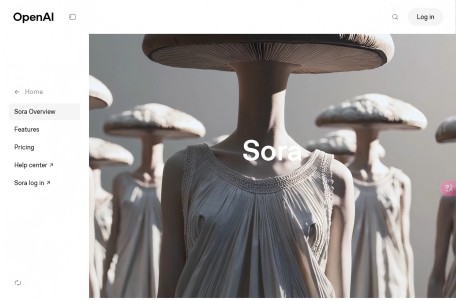
What is Sora?
Sora is an AI video generation model developed by OpenAI. It has the ability to convert text descriptions into videos and can create video scenes that are both realistic and imaginative. This model focuses on simulating the motion of the physical world, aiming to help people solve problems that require real-world interactions. Compared with AI video tools such as Pika, Runway, PixVerse, Morph Studio, and Genmo, which can only generate videos of four or five seconds, Sora can generate videos up to one minute long while maintaining visual quality and a high degree of fidelity to user input. Besides creating videos from scratch, Sora can also generate animations based on existing static images or expand and complete existing videos.
It should be noted that although Sora seems to have very powerful functions, it is not officially open to the public yet. OpenAI is currently conducting red team testing, security checks and optimizations on it. At present, OpenAI’s official website only has introductions to Sora, video demos and technical explanations, and has not yet provided a directly usable video generation tool or API. The website madewithsora.com has collected videos generated by Sora. Interested friends can go and watch.
The main functions of Sora
- Text-driven Video Generation: Sora can generate video content that matches the detailed text descriptions provided by users. These descriptions can cover multiple aspects such as scenes, characters, actions, and emotions.
- Video Quality and Fidelity: The generated videos maintain high-quality visual effects and closely follow the user’s text prompts to ensure that the video content matches the description.
- Simulating the Physical World: Sora aims to simulate the movements and physical laws of the real world, making the generated videos more visually realistic and capable of handling complex scenes and character actions.
- Handling Multi-character and Complex Scenes: The model can handle video generation tasks that include multiple characters and complex backgrounds, although there may be limitations in some cases.
- Video Extension and Completion: Sora can not only generate videos from scratch but also create animations based on existing static images or video clips or extend the length of existing videos.
The Technical Principles of Sora
- Text – Conditional Generation: The Sora model can generate videos based on text prompts, which is achieved by combining text information with video content. This ability enables the model to understand user descriptions and generate video clips that match them.
- Visual Patches: Sora decomposes videos and images into small visual patches, serving as low – dimensional representations of videos and images. This method allows the model to process and understand complex visual information while maintaining computational efficiency.
- Video Compression Network: Before generating videos, Sora uses a video compression network to compress the original video data into a low – dimensional latent space. This compression process reduces the complexity of the data, making it easier for the model to learn and generate video content.
- Spacetime Patches: After video compression, Sora further decomposes the video representation into a series of spacetime patches as inputs for the model, enabling the model to process and understand the spatio – temporal characteristics of videos.
- Diffusion Model: Sora adopts a diffusion model (DiT model based on the Transformer architecture) as its core generation mechanism. The diffusion model generates content by gradually removing noise and predicting the original data. In video generation, this means that the model starts from a series of noisy patches and gradually restores clear video frames.
- Transformer Architecture: Sora utilizes the Transformer architecture to process spacetime patches. The Transformer is a powerful neural network model that performs excellently in handling sequential data (such as text and time series). In Sora, the Transformer is used to understand and generate video frame sequences.
- Large – Scale Training: Sora is trained on a large – scale video dataset, enabling the model to learn rich visual patterns and dynamic changes. Large – scale training helps improve the model’s generalization ability, allowing it to generate diverse and high – quality video content.
- Text – to – Video Generation: Sora trains a descriptive caption generator to convert text prompts into detailed video descriptions. Then, these descriptions are used to guide the video generation process, ensuring that the generated video content matches the text descriptions.
- Zero – Shot Learning: Sora can perform specific tasks through zero – shot learning, such as simulating videos or games in specific styles. That is, the model can generate corresponding video content based on text prompts without direct training data.
- Simulating the Physical World: Sora has demonstrated the ability to simulate the physical world during training, such as 3D consistency and object permanence, indicating that the model can understand and simulate physical laws in the real world to a certain extent.
Application scenarios of Sora
- Social Media Short Video Production: Content creators can quickly produce appealing short videos for sharing on social media platforms. Creators can easily transform their ideas into videos without having to invest a great deal of time and resources in learning video editing software. Sora can also generate video content suitable for specific formats and styles according to the characteristics of social media platforms (such as short videos, live broadcasts, etc.).
- Advertising Marketing: Quickly generate advertising videos to help brands convey their core information in a short time. Sora can generate animations with strong visual impact or simulate real scenarios to showcase product features. In addition, Sora can assist enterprises in testing different advertising creatives and find the most effective marketing strategies through rapid iteration.
- Prototype Design and Concept Visualization: For designers and engineers, Sora can be a powerful tool to visualize their designs and concepts. For example, architects can use Sora to generate three-dimensional animations of architectural projects, enabling clients to understand the design intentions more intuitively. Product designers can utilize Sora to demonstrate the working principles or user experience processes of new products.
- Film and Television Production: Assist directors and producers in quickly constructing storyboards during pre-production, or generating initial visual effects. This can help the team better plan scenes and shots before actual shooting. In addition, Sora can be used to generate special effects previews, allowing the production team to explore different visual effects within a limited budget.
- Education and Training: Sora can be used to create educational videos to help students better understand complex concepts. For example, it can generate simulation videos of scientific experiments or reenactments of historical events, making the learning process more vivid and intuitive.
How to Use Sora
OpenAI Sora currently does not provide a publicly accessible entry point for use. This model is undergoing evaluation by the Red Team (security experts) and is only being tested and evaluated for a small number of visual artists, designers, and filmmakers. OpenAI has not specified a specific timetable for broader public availability, but it may be at some point in 2024. If you want to obtain access rights now, individuals need to qualify according to the expert criteria defined by OpenAI, which includes belonging to relevant professional groups involved in evaluating the usefulness of the model and mitigating risk strategies.
Similar Sites


Segment Anything (SAM)

AnythingLLM

Colourlab.ai

Viggle

Chatbox AI

Humva

PixVerse

